ARCHIVED - Natural Resources Canada
 This page has been archived.
This page has been archived.
Archived Content
Information identified as archived on the Web is for reference, research or recordkeeping purposes. It has not been altered or updated after the date of archiving. Web pages that are archived on the Web are not subject to the Government of Canada Web Standards. As per the Communications Policy of the Government of Canada, you can request alternate formats on the "Contact Us" page.
2009-10
Report on Plans and Priorities
Natural Resources Canada
The original version was signed by
The Honourable Lisa Raitt, P.C., M.P.
Minister of Natural Resources
Table of Contents
Strategic Outcomes and Program Activity Architecture
Section II – Analysis of Program Activities by Strategic Outcome
Section III – Supplementary Information
Minister's Message

It is my pleasure to present the 2009–10 Report on Plans and Priorities of Natural Resources Canada (NRCan), a description of the department's roadmap for the coming fiscal year and a summary of the value that we will deliver to Canadians.
Our Government's vision for natural resources — improving the quality of life for Canadians by creating a sustainable resource advantage — drives all our activities. It is a vision that all stakeholders in natural resources can strive to attain, binding our collective efforts from coast to coast to coast. Our Government's role in fulfilling this vision is to orient our activities toward economic competitiveness, environmental responsibility, and safety, security and sound stewardship.
In Canada, natural resources are fundamental to the strength of our economy. In 2007 alone, the sectors generated more than 12 percent, or $155 billion, of Canada's gross domestic product and directly employed close to 900,000 people. Yet, as all Canadians are aware, the recent global financial crisis has unleashed a worldwide economic recession. Demand for, and prices of all natural resources have declined, and restricted credit is impeding needed investments. As demonstrated in Budget 2009 — Canada's Economic Action Plan — and in measures announced earlier, our Government has responded quickly and decisively to keep our economy moving and to protect Canadians. These measures will provide short-term economic stimulus and will also help achieve long-term goals for a prosperous, sustainable and secure future.
NRCan's role in this response includes short-term measures such as extending the ecoENERGY Retrofit for Homes Program to help more Canadian homeowners control their energy costs and contribute to the health of our environment. In addition, NRCan will support the federal Regional Development Agencies which are responsible for the delivery of the Community Adjustment Fund that will benefit communities, including those that are resource-dependent. For the long-term positioning of the energy industry, NRCan will work to implement the new Clean Energy Fund that will invest in promising clean energy technologies (e.g., carbon capture and storage). To help Canada's forest sector, the department will support the development of new technologies and pilot-scale demonstration projects (e.g., bio-refineries) and create new opportunities through market diversification.
Furthermore, NRCan will be working closely with other departments and agencies to implement important initiatives, including strengthening Canada's nuclear advantage, maintaining key Arctic research facilities, and extending the Mineral Exploration Tax Credit. Combined, these short-term and long-term initiatives will provide the natural resource sectors with opportunities to improve economic competitiveness and enhance environmental performance.
These targeted initiatives supplement and enhance NRCan's wide range of ongoing activities, from our work to increase the transparency and timeliness of the regulatory review of major natural resource projects, to supporting Canada's sovereignty in the North.
NRCan strives to deliver the highest standard of service to Canadians. The department is accessible to our major stakeholders, a champion of ideas and innovation, and accountable for the results it delivers on behalf of the Government of Canada. Through this approach, NRCan is creating a sustainable resource advantage for all Canadians.
The Honourable Lisa Raitt, P.C., M.P.
Minister of Natural Resources
Section I – Overview
OUR VISION
Improving the quality of life of Canadians by creating a sustainable resource advantage
OUR MISSION
To be a champion of sustainable development;
a world-class centre of knowledge on natural resources; and
a leader in policy and science
Raison d'être
NRCan's goal is to create a sustainable resource advantage for Canadians, now and in the future. The department works to improve the competitiveness of Canada's natural resource sectors, which provide jobs and income for Canadian families across the country. The department strives to ensure that resource development takes place sustainably and advances Canada's leadership on the environment. NRCan also supports some of the most basic safety and security obligations a country has to its citizens through its knowledge and expertise on Canada's vast and diverse landmass.
Responsibilities
NRCan has a responsibility to help create a more secure and sustainable resource future for Canadians. Energy, minerals, metals, wood and water, in one form or another, are integral to the daily lives of every citizen. And Canada is fortunate to have one of the largest, most diverse natural resource endowments in the world.
Ministerial Responsibilities – The Minister of Natural Resources is responsible for, or has responsibilities under, more than 30 Acts of Parliament. The core powers, duties and functions are set forth in the Department of Natural Resources Act, the Resources and Technical Surveys Act, and the Forestry Act. The remaining Acts set out the terms for the management of Crown lands and of Canada's natural resource policies, including energy and nuclear policy.
Today, however, it is no longer just about the resources. It is about transforming these resources into value-added products and keeping high-quality jobs in Canada. It is about producing and using natural resources in cleaner and greener ways. In short, it is about combining the resource base with people, knowledge, expertise, and systems (e.g., regulation, infrastructure) to improve the quality of life for Canadians.
The global economic downturn, dropping demand for natural resources and continued price volatility do not change this new reality. Indeed, they serve to sharpen it. Canada's success as a sustainable resource leader hinges on its ability to bring together the strengths of all of its assets through these difficult economic times – namely, its resource base, people and ideas, and systems. NRCan, as the primary federal partner in natural resources with the provinces, territories, corporations and others, is working hard to help deliver necessary economic stimulus. At the same time, NRCan is helping to position Canada for the future by improving its economic competitiveness, advancing its environmental leadership and enhancing the safety and security of Canadians.
NRCan is achieving these objectives in several ways. Through measures announced in Budget 2009, the department is supporting the Government-wide effort to stimulate the economy. For example, the two year expansion of the ecoENERGY Retrofit for Homes Program will improve the efficiency of over 200,000 homes, support jobs in the home renovation industry, reduce long-term energy costs for homeowners and decrease greenhouse gas emissions. As well, NRCan will support the federal Regional Development Agencies (RDAs) who are responsible for delivering the new Community Adjustment Fund, which will help create employment opportunities in communities affected by the economic downturn across Canada, including those depending on mining and forestry.
NRCan is also working closely with the forest sector to develop new technologies and products, diversify markets and support communities in transition. To these ends, Budget 2009 provided additional support for the development of new technologies and forest products and for the diversification of markets at home and abroad. In energy, NRCan is playing a pivotal role in developing breakthrough clean technologies, such as carbon capture and storage. The Clean Energy Fund, announced in Budget 2009, will invest significantly in green energy technologies to move Canada toward a low-carbon future. These and other measures will help keep high-quality jobs in Canada, drive innovation, and strengthen Canada's resource competitiveness – better positioning the country for economic recovery.
In addition, NRCan creates and shares vital scientific information. Its geoscience expertise has led to significant discoveries such as diamond and gas deposits in Canada's North. This expertise underpins the competitiveness of Canada's mining and energy industries and helps play a significant role in supporting Canada's United Nations Convention on the Laws of the Sea (UNCLOS) claim. Other NRCan work supports the development of green mining technology. This extends the life of existing mine sites and improves environmental practices. In addition, NRCan-led science related to natural hazards (e.g., earth quakes, tsunamis and wildland fires) results in better understanding and protection for Canadians.
As well, the department is the federal lead on nuclear energy policy. It works to maximize the economic and environmental benefits from this non-greenhouse gas emitting source of electrical power. Through a suite of ecoENERGY initiatives, NRCan also promotes energy efficiency, the production of renewable energy, and the development of new energy technologies. These are helping to create new green economic opportunities. These initiatives and others support the government's goal of having 90% of Canada's electricity generated from non-emitting sources by 2020.
To further facilitate responsible resource development, NRCan is also focused on strengthening Canada's regulatory system. It is working to improve the predictability, accountability and effectiveness of Canada's environmental regulations, most notably through the efforts of the Major Projects Management Office. This approach is essential to maximizing the economic benefits of Canada's natural resources while maintaining sound environmental stewardship for the well-being of all Canadians.
Strategic Outcomes and Program Activity Architecture
NRCan's goal is to create a sustainable resource advantage for Canadians by embracing the idea that economic competitiveness includes environmental leadership. In working collaboratively with other partners, the department's role is to help bring together the strengths of all of Canada's natural resource assets – its endowment of energy, forests and minerals, people and ideas, and systems – to achieve three inter-related strategic outcomes for Canadians: enhancing the economic competitiveness and productivity of the natural resource sectors so that they continue to contribute to the prosperity and social well-being of Canadians; making Canada a world leader in terms of environmental responsibility in the development and use of natural resources; and providing for the safety and security of Canadians within a natural resource context, as well as for the stewardship of Canada's natural resources and lands.
NRCan manages its program delivery through these three strategic outcomes, which have seven program activities. The program activities are divided into smaller groups of sub-activities and sub-sub-activities that are designed to achieve the expected results that collectively contribute to the realization of strategic outcomes.
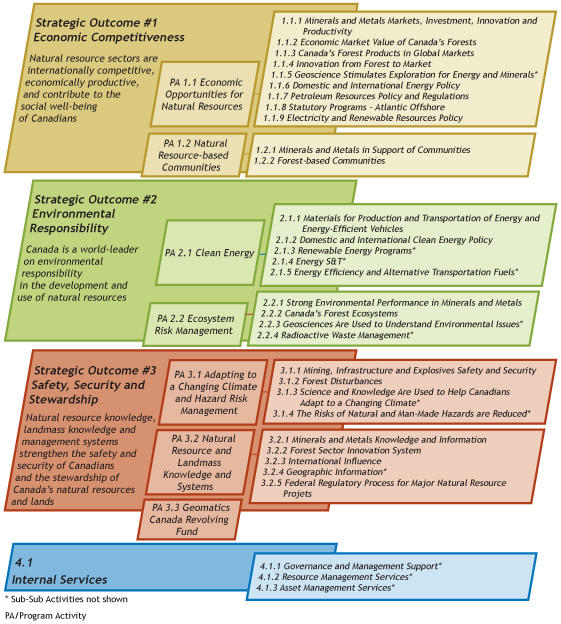
PA = Program Activity
Planning Summary
| Planned Spending | 2009-10 | 2010-11 | 2011-12 |
|---|---|---|---|
| Program Spending | 1,466.7 | 1,643.6 | 1,111.3 |
| Statutory Programs – Atlantic Offshore | 2,409.3 | 1,412.9 | 844.6 |
| Total | 3,876.0 | 3,056.5 | 1,955.9 |
| 2009-10 | 2010-11 | 2011-12 |
|---|---|---|
| 4,513 | 4,472 | 4,181 |
Planned Spending
The table below provides detailed information on the department's planned spending by program activity, expected results and alignment to the Government of Canada outcomes. The financial content of this report also contains planned spending related to the following NRCan initiatives approved since the preparation of Main Estimates in February 2009. These are: CANMET Materials Technology Laboratory Relocation — $14.7 million in 2009-10, $20.9M in 2010-11 and $16.6 million in 2011-12; and Renewable Fuel Regulation — $1.4 million in 2009-10 and $1.4 million in 2010-11. It also makes reference to spending announced in Budget 2009: ecoENERGY Retrofit Program — $150 million in 2009-10 and $150 million in 2010-11; Forest Market Diversification and Innovation — $70 million in 2009-10 and $100 million in 2010-11. The new Clean Energy Fund, also announced in Budget 2009, is not incorporated into NRCan planned spending as its program parameters and delivery mechanism were not fully determined at the time of the writing of this report.
| Performance Indicator |
|---|
| Contribution of natural resource sectors to the annual GDP |
| Program Activity (Main Estimates) |
Expected Results | Forecast Spending 2008-09 ($M) |
Planned Spending ($M) | Alignment to GoC Outcomes (or statutory obligations) | ||
|---|---|---|---|---|---|---|
| 2009-2010 | 2010-2011 | 2011-2012 | ||||
| 1.1 Economic opportunities for natural resources | Competitive national and international markets, stable economic opportunity and investment in natural resources | 168.2 | 226.1 | 243.9 | 137.8 | Strong Economic Growth |
| 1.2 Natural resource-based communities | Increased knowledge, skills and capacity to benefit from the evolving natural resource economy within resource-based communities (both Aboriginal and non-Aboriginal) | 24.4 | 11.1 | 11.1 | 11.1 | Strong Economic Growth |
| Performance Indicators |
|---|
| Extent of NRCan knowledge in natural resources management and land-use decisions |
| Percent rate of Canada's environmental performance compared to other countries |
| Program Activity | Expected Results | Forecast Spending 2008-09 ($M) |
Planned Spending ($M) | Alignment to GoC Outcomes (or statutory obligations) | ||
|---|---|---|---|---|---|---|
| 2009-2010 | 2010-2011 | 2011-2012 | ||||
| 2.1 Clean energy[1] | Increased energy efficiency, increased production of low-emission energy, and reduced environmental impacts associated with energy production and use | 516.3 | 708.3 | 900.8 | 597.7 | A Clean and Healthy Environment |
| 2.2 Ecosystem risk management[2] | Canada understands and mitigates risks to natural resource ecosystems and human health | 210.9 | 169.4 | 173.2 | 73.7 | A Clean and Healthy Environment |
| Performance Indicators |
|---|
| Extent to which the Minister's obligations are met |
| Rate in uptake of NRCan's information by users |
| Program Activity | Expected Results | Forecast Spending 2008-09 ($M) |
Planned Spending ($M) | Alignment to GoC Outcomes (or statutory obligations) | ||
|---|---|---|---|---|---|---|
| 2009-2010 | 2010-2011 | 2011-2012 | ||||
| 3.1 Adapting to a changing climate and hazard risk management[3] | Canada adapts to a changing climate and has the knowledge and tools to manage risks associated with natural hazards and hazards arising from human activities | 109.9 | 73.1 | 59.0 | 59.0 | An Innovative and Knowledge-based Economy |
| 3.2 Natural resource and landmass knowledge and systems[4] | Canada has the natural resource and landmass knowledge to contribute to the development of the country through maps, property rights, boundary management, statistics and integrated decision making, and plays a leadership role in federal/provincial/ territorial and international fora | 111.6 | 101.7 | 81.7 | 66.5 | An Innovative and Knowledge-based Economy |
| 3.3 Geomatics Canada Revolving Fund[5] | The demand by NRCan, other government departments and industrial clients for revolving fund products and services is met through full cost recovery | 1.9 (1.9) |
1.9 (1.9) |
1.9 (1.9) |
1.9 (1.9) |
An Innovative and Knowledge-based Economy |
| 4.1 Internal services | 176.7 | 177.0 | 173.9 | 165.5 | ||
| Sub-Total | 1,318.0 | 1,466.7 | 1,643.6 | 1,111.3 | ||
| Statutory Programs | ||||||
| 1.1 Economic opportunities for natural resources[6] | Competitive national and international markets, stable economic opportunity and investment in natural resources | 3,204.0 | 2,409.3 | 1,412.9 | 844.6 | Statutory Obligations |
| Total NRCan[7] | 4,522.0 | 3,876.0 | 3,056.5 | 1,955.9 | ||
Contribution of Priorities to Strategic Outcome
NRCan has identified the priorities that are critical to the realization of its strategic outcomes (SO)[8] and expected results over the planning period. These priorities shape the department's integrated effort in the development of its policies, pursuit of its science and technology initiatives, and delivery of its programs towards the strengthening of the three key assets of Canada's sustainable resource advantage: resources, people and ideas, and systems.
| Address climate change and air quality through clean energy | |
| The objective of this priority is to strengthen the sustainability of Canadian energy production and consumption. Under this priority, NRCan is administering the major new Clean Energy Fund, announced in Budget 2009, for substantial investments in the research, development, and large-scale demonstration of clean energy technologies. This includes carbon capture and storage, a promising technology with the potential to substantially reduce greenhouse gas emissions from North America's vast endowment of conventional energy reserves, in particular oil sands and coal. The Government of Canada is coordinating this work with the Government of the United States for an integrated and cooperative solution to this issue of major importance to our two nations' economies, shared environment, and mutual security. The department will also continue the delivery of its key suite of ecoENERGY programs under the Government's broader ecoACTION plan. These programs range from support for building retrofits and vehicle initiatives, through to technology development, renewable power, and biofuels. The ecoENERGY Retrofit program – which supports home renovations that improve energy efficiency, and is of particular benefit to middle-income Canadians – was significantly enhanced in Budget 2009. Finally, and in partnership with Environment Canada, NRCan will develop the backbone of a federal climate change adaptation framework. | Previously Committed Priority |
| Linked to SO #2 & 3 | |
| Support forest sector restructuring and a healthy forest | |
| The objective of this priority is to support sustainable and transformative change of Canada's forest sector that will improve the long-term economic competitiveness and sustainable management of Canada's forests, while at the same time supporting the sector in the short term as it manages through the current global recession. NRCan will deliver on this priority with substantial new funding for FPInnovations – Canada's integrated forest products research institute – for the acceleration of a long-term research agenda focusing on the development of knowledge and technologies to transform the forest sector with new products and new end-uses for wood fibre. As a key contribution to this effort, NRCan will ensure that its own Canadian Wood Fibre Centre develops options and opportunities to improve the economic value of Canada's forest resources. NRCan will also make new substantial contributions to growing a broader portfolio of forest product markets, both at home and abroad, and will ensure that the environmental reputation of the sector reflects the reality of its strong record of sustainability. More broadly, NRCan will lead the development of a national forest innovation system and strengthen strategic linkages among key forest sector stakeholders. | Previously Committed Priority |
| Linked to SO #1, 2 & 3 | |
| Strengthen Canada's minerals, metals and materials industries | |
| The objective of this priority is to support the minerals, metals and materials industries by encouraging economic competitiveness, and environmental and social responsibility and by preserving and enhancing market access. As key elements of delivering on this priority NRCan will renew and relocate its world-class CANMET Materials Technology Laboratory to the McMaster Innovation Park in Hamilton, Ontario, and launch its Green Mining Initiative, including the demonstration of the transformation of organic waste into productive land for biofuel crops. More broadly, NRCan will continue to contribute to the implementation of a pan-Canadian mining research and innovation strategy through the Canadian Mining Innovation Council; support access to global markets for Canadian minerals, metals and materials based on transparency of rules and sound science; and work with key stakeholders such as the Prospectors and Developers Association of Canada and the Mining Association of Canada, in promoting best practices and corporate social responsibility activities by the minerals and metals industry. Long-term support for this priority – by the renewal of Canada's mineral and metal resource asset base – will be delivered by NRCan via the minerals component of the Geo-mapping for Energy and Minerals (GEM) Program, and via the Targeted Geoscience Initiative 3 for existing base metal mining communities. | Ongoing Priority |
| Linked to SO #1, 2 & 3 | |
| Advance Canada's resource interests and sustainability efforts in the Americas and globally | |
| The objective of this priority is to leverage Canada's sustainable resource advantage for domestic and international economic growth, including short-term economic stabilization and recovery. NRCan will deliver on this priority by promoting and enhancing Canada's resource trade interests through programs such as Canada Wood Export and Leadership for Environmental Advantage in Forestry; and will provide support – together with the Department of Foreign Affairs & International Trade, and the Canadian International Development Agency – to the National Roundtables on Corporate Social Responsibility and the Extractive Industries in Developing Countries. NRCan will also continue to work with its counterparts in the U.S. Administration on clean energy technologies (such as carbon capture and storage), energy efficiency standards, renewable fuels, energy infrastructure and regulation, and the assurance of North American clean energy security. | Ongoing Priority |
| Linked to SO #1 & 2 | |
| Support Canada's Arctic strategy and develop resource potential in the North | |
| The objective of this priority is to support the evolution of strong and dynamic northern regions. NRCan will deliver on this priority by stimulating investment in Canada's mineral and energy resources in the North via the Geo-mapping for Energy and Minerals Program. The potential for extending Canada's energy resource base will also be pursued by NRCan research on the development potential of northern gas hydrates. In partnership with the departments of Fisheries and Oceans, and Foreign Affairs and International Trade, NRCan will also deliver the United Nations Commission on the Law of Sea Program for the delineation of Canada's continental shelf. Development of Canada's northern infrastructure will be supported by efficient regulatory review of significant projects such as the Mackenzie and Alaska natural gas projects. Finally, NRCan will work with Indian and Northern Affairs Canada and other federal departments on the creation of a new northern asset, the Canadian Arctic Research Institute. NRCan will also play a key role in supporting Canada's Vision for the North by making the case for satellite ground stations in the North. | Ongoing Priority |
| Linked to SO #1 & 3 | |
| Improve regulatory performance for major natural resource projects | |
| The objective of this priority is to ensure that Canada's sustainable resource advantage is enhanced by a stable, timely, well-coordinated and evidence-based regulatory process. NRCan will continue with the implementation of the Major Projects Management Office (MPMO) initiative to improve federal regulatory management, accountability, and timeliness. This activity include identifying and implementing improvements to the federal legislative and/or regulatory framework, as well as opportunities to improve harmonization with provincial processes. Of particular importance, the MPMO will develop and implement a whole-of-government approach to Crown-Aboriginal consultations. As part of its ongoing business, NRCan will also deliver environmental expert reviews to ensure that environmental impacts are identified and mitigated prior to projects proceeding. | Previously Committed Priority |
| Linked to SO #1, 2 & 3 | |
| Strengthen the Canadian nuclear industry | |
| The objective of this priority is to strengthen Canada's nuclear advantage. NRCan will deliver on this priority in partnership with key entities in the Minister's portfolio and other government departments. In particular, NRCan will support Atomic Energy of Canada Limited's (AECL) efforts toward the renewal of its research and development capacity and infrastructure and the development of the advanced CANDU reactor. NRCan will review AECL's structure to ensure that it is appropriate in a changing marketplace and positions Canada's nuclear industry to take maximum advantage of domestic and international opportunities. NRCan will also support the Canadian Nuclear Safety Commission in its efforts to improve the effectiveness and efficiency of the regulatory approvals process. Together with Health Canada, NRCan will work to ensure that Canadians have a secure supply of medical isotopes. Finally, NRCan will continue to manage the Government of Canada's nuclear legacy liabilities. | New Priority |
| Linked to SO #1 & 3 | |
| Implement an integrated strategic framework and integrated planning and reporting | |
| The objective of this priority is to rejuvenate NRCan's capacity to support the Canadian sustainable resource advantage by implementing integrated, advanced management systems. NRCan will deliver on this priority through human resource renewal, implementation of an enduring NRCan Strategic Framework, adoption of advanced knowledge management and collaborative technologies and ensuring the seamless integration of its science and policy sectors. NRCan will also continue the implementation of its integrated planning and reporting processes and enhance the efficiency and effectiveness of its internal services (human resources, financial management, information management, information technology, systems and controls, real property management, security management, environmental management and procurement). | New Priority |
| Linked to SO #1, 2 & 3 | |
| Better integration and management of the natural resources portfolio | |
| The objective of this priority is to harmonize the Minister's diverse natural resources portfolio. To deliver on this priority, NRCan will strengthen, tighten and deepen formal portfolio administrative structures in ways that are appropriate for the roles, responsibilities, and requirements of all portfolio entities and for the Minister of Natural Resources (e.g., policy and operational initiatives, appointments and the parliamentary interface). | New Priority |
| Linked to SO #1, 2 & 3 | |
Risk Analysis
Given its role as the primary federal partner in natural resources, NRCan is actively managing a range of significant risks and opportunities. Under the current context, the immediate focus of attention is the risks created by the global economic recession while over the long term, improving competitiveness and sustainability are the key watchwords. These risks, and others pertaining to the delivery of NRCan's entire suite of priorities and on-going activities, are being closely monitored at the executive level.
Global Financial Crisis and Recession
Ongoing financial market disruptions and the global recession are negatively affecting Canada's natural resource sectors. Companies are facing an extended period of high borrowing costs and reduced availability of credit. At the same time, commodity prices remain volatile. Resource companies are laying off workers, suspending production and delaying major investments. These actions are dramatically affecting communities across the country.
Canada's forest industry has been undergoing major restructuring over the last few years due to increasing global competition, aging capital stock and increasing costs. The industry continues to struggle as the prices of its products have declined steadily. The global recession and in particular the collapse of the US housing markets is only exacerbating factors contributing to substantial job losses.
Since the middle of 2008, the prices for most metals and minerals have retreated at a pace and on a scale exceeding those of the period of 1929-33. This weakness in the prices of minerals and metals has resulted in reduced expenditures on exploration, the closure of mines, the reduction of output and the deferral of capital investment. These effects have resulted in layoffs and job losses in both mining and smelting with further cuts expected in the coming year.
The energy industry is not immune to the challenges and risks of the global economy. Canadian petroleum production is expected to decline due to decreasing global demand as well as general uncertainty. Capital spending in the oil and gas industry has declined, along with drilling activity. These pressures come at a time when the industry is facing increasing challenges related to the renewal and expansion of infrastructure, as well as improving environmental performance. Climate change and greenhouse gas emissions remain key areas of concern in the development of energy projects, with technology playing a critical role in addressing these risks.
Taking Action
The government is taking steps to address these risks through a suite of measures announced in Budget 2009. NRCan is working to implement several key measures that will provide immediate economic stimulus and promote the long-term competitiveness of the natural resource sectors. A major initiative for NRCan that will provide economic stimulus is the additional $300 million for the ecoENERGY Retrofit for Homes Program. This investment will help retrofit up to an additional 200,000 homes — stimulating consumer spending while maintaining and creating jobs (e.g., the home renovation and the energy audit industries). Through the provision of incentives, the program will improve the energy efficiency of the Canadian housing stock, thus saving money for homeowners and reducing greenhouse gas emissions.
The department will also support the federal Regional Development Agencies (RDAs) that are responsible for delivering the $1-billion Community Adjustment Fund announced in Budget 2009. This fund will address impacts and risks at the community level by fostering economic development and provide immediate stimulus for communities affected by the economic downturn across the country — including those that are resource-dependent.
Budget 2009 provides $80 million over two years to NRCan for the Transformative Technologies Program administered by FPInnovations, Canada's national forest research institute that focuses on the development of emerging and breakthrough technologies related to forest biomass utilization, nanotechnology and next generation forest products, and includes support for the NRCan-created Canadian Wood Fibre Centre. An additional $40 million will be provided to develop pilot-scale demonstration projects for new products that can be used in commercial applications. The Budget also provides NRCan with $40 million to help forestry companies market their innovative products internationally. An additional $10 million will support large-scale demonstrations of Canadian-style uses of wood for construction in targeted offshore markets and non-traditional uses of wood in domestic markets.
Budget 2009 also announced a $1-billion Clean Energy Fund that will support the research, development and demonstration of promising clean energy technologies, including technologies such as large-scale carbon capture and storage projects. This investment will support green jobs and help improve Canada's reputation as a clean energy superpower. The fund will better position Canada to meet climate change objectives and also maintain critical market access to the U.S.
The Government will need to remain flexible in its approach to addressing the negative impacts of the recession while steering a clear course to recovery. To remain responsive to the fluid economic situation, NRCan is tracking and assessing mill and mine closures, project investment delays and the associated employment and community impacts. In addition, the department is working collaboratively with industry, provinces and other federal departments on related issues such as further measures to support workers and natural resources companies.
Ongoing Risk Analysis and Management
Beyond the risks to Canada's resource sectors arising from the global recession, and the specific measures in Budget 2009 that are being implemented to address these risks, NRCan is actively engaged in the monitoring and management of a range of other risks and opportunities with the potential to affect its priorities, and on-going activities. These include: the potential for delays or cost pressures associated with the renewal and relocation and renewal of the world-class CANMET Materials Technology Laboratory to the McMaster Innovation Park (Hamilton, Ontario); the monitoring of the production of medical isotopes from the National Research Universal (NRU) reactor, in cooperation with Atomic Energy of Canada Limited; and the time constraints, and technical and operational challenges of the United Nations Convention on the Law of the Sea (UNCLOS) program for delimiting the outer limits of Canada's Arctic and Atlantic continental shelf.
Expenditure Profile
NRCan plans to spend $3,876.0 million in fiscal year 2009-10 to support its role to enhance the responsible development and use of Canada's natural resources, including energy, forests and minerals and metals. Included in this amount is $2,409.3 million in planned spending for the Atlantic Offshore Accords statutory payments. The Accords provide that the benefits of revenues from the offshore should flow to provinces as if the resources were on land and direct that these revenues be collected by the Receiver General for Canada, with a like amount to be paid to the provinces (Newfoundland and Labrador, Nova Scotia). As the amounts credited to the Receiver General and paid out of the Revenue Fund are the same, there is no net liability incurred by the federal government as a result of the increase in payments to the provinces. The graph illustrates the following key points:
- A relatively small increase in NRCan's spending trend for fiscal year 2005-06 to 2007-08. The trend is expected to continue through the 2010-11 fiscal year, before dropping off in the 2011-12 fiscal year.
- Increases to the forecast spending in fiscal year 2008-09 are comprised mainly of increases to ecoENERGY for Biofuels initiative and the Clean Energy Agenda (our contribution to the Government's Clean Air Agenda)
- The planned spending increases for fiscal year 2009-10 are attributed to the ecoENERGY for Biofuels initiative and Budget 2009 announcements for ecoENERGY Retrofit Program and Forestry Market Diversification and Innovation. The new Clean Energy Fund, also announced in Budget 2009, is not incorporated into NRCan planned spending as its program parameters and delivery mechanism were not fully determined at the writing of this report.
- The planned spending increases for fiscal year 2010-11 are attributed to the Clean Energy Agenda, the ecoENERGY for Biofuels initiative, the Sustainable Development Technology Canada initiatives, and Budget 2009 announcements for ecoENERGY Retrofit Program, and Forestry Market Diversification and Innovation.
- The decreased planned spending in 2011-12 is the result of sunsetting and reduced funding for initiatives including Clear Air Regulatory Agenda, Clean Energy Agenda, Nuclear Legacy Liabilities and ecoENERGY for Biofuels.
- The statutory payments under the various Atlantic Offshore Accords are based primarily on oil and gas royalty revenues received. Royalty revenues are affected by both the price of oil and production levels. The significant increase in actual expenditures is largely a result of the significant increase in oil prices experienced in the 2007-08 fiscal year. The anticipated spending increase and subsequent reduction in planned spending in subsequent years reflect the latest forecast of offshore related revenue that the federal government expects to collect over the planning period.
Departmental Spending Trend ($M)
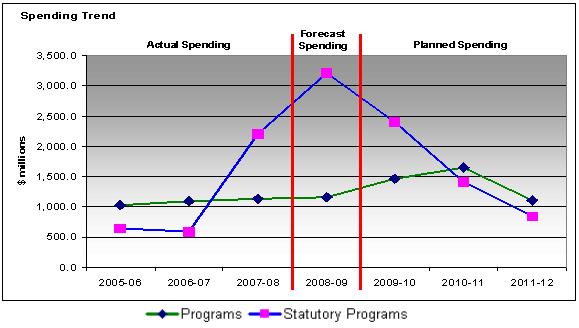
2009-10 Allocation of Funding by Program Activity
The chart below reflects the allocation of NRCan's planned spending by program activity for the 2009-10 fiscal year. The statutory payments under the Atlantic Offshore Accords make up the largest portion of the funding. These payments fall under the Economic Opportunities for Natural Resources program activity but are shown separately due to the large dollar value and the legislated nature of the payments.
Expected results under this program activity are competitive national and international markets, stable economic opportunity and investment in natural resources. The Clean Energy program activity has the next highest planned spending. Spending under this program activity promotes increased energy efficiency, increased production of low-emission energy and reduced environmental impacts associated with energy production and use. The balance of the planned spending for the remaining program activities is less than 5 percent of the total budget in each case.
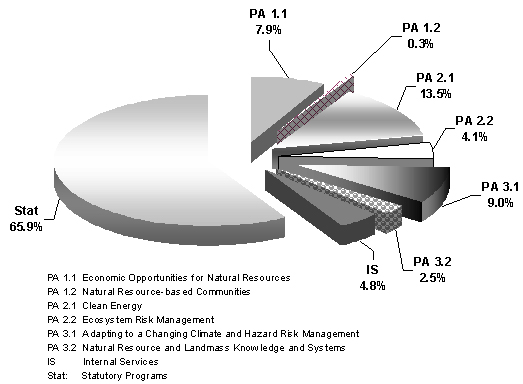
| Voted or Statutory Items | Truncated Vote or Statutory Wording | Main Estimates ($M) 2008-09 |
Main Estimates ($M) 2009-10 |
|---|---|---|---|
| 1[9] | Operating expenditures | 762.9 | 700.3 |
| 5[10] | Grants and Contributions | 437.9 | 457.0 |
| (S) | Minister of Natural Resources – Salary and Motor Car Allowance | 0.1 | 0.1 |
| (S) | Contributions to Employee Benefit Plans | 54.6 | 53.2 |
| (S) | Infrastructure costs relating to the exploration, development, production or transportation of oil and gas in the offshore area of Nova Scotia[*] | 0.5 | 1.4 |
| (S) | Canada-Newfoundland Offshore Petroleum Board[*] | 6.0 | 7.2 |
| (S) | Canada-Nova Scotia Offshore Petroleum Board[*] | 2.9 | 3.4 |
| (S) | Payments to the Nova Scotia Offshore Revenue Account[*] | 407.3 | 351.5 |
| (S) | Payments to the Newfoundland Offshore Petroleum Resource Revenue Fund[*] | 670.6 | 2,045.9 |
| (S)[11] | Grant to the Canada Foundation for Sustainable Development Technology | 0.0 | 20.0 |
| (S) | Geomatics Canada Revolving Fund - Operational expenditures - Respendable revenue |
1.9 (1.9) |
1.9 (1.9) |
| Main Estimates | 2,342.8 | 3,639.9 | |
| Adjustments | |||
| - Supplementary Estimates Appropriated | 38.6 | ||
| - Supplementary Estimates Statutory | 2,140.6 | ||
| - New Items and Announcements | 236.1 | ||
| Total Planned Spending | 4,522.0 | 3,876.0 | |
* Pursuant to the Atlantic Offshore Accords, NRCan makes payments to the provinces of Newfoundland and Labrador and Nova Scotia (see notes under Expenditure Profile). This increase reflects the latest forecast of offshore-related revenue that the federal government expects to collect over the planning period.
Section II – Analysis of Program Activities by Strategic Outcome
This section provides information about NRCan's results structure (Strategic Outcomes and Program Activity Architecture), that reflects a horizontal approach to program delivery and fosters collective leadership across the department. More information about departmental programs and initiatives can be found at www.nrcan.gc.ca.
Planning Context
Canada is being impacted by external shocks that are directly affecting its natural resource sectors: a worldwide economic downturn, a sharp decline in the prices of many commodities, the decline in the availability of credit, and the global increase in financing costs. In this context, demand for Canada's resources has declined and the investment climate for new capital-intensive resource projects has deteriorated. These externally driven conditions must be considered as NRCan works to ensure the economic competiveness and sustainability of Canada's natural resource sectors.
Certain sectors are also facing other long-term, structural challenges. The Canadian forest industry has been adjusting to a number of global and domestic circumstances, including new low-cost competitors, shifting markets and investment, as well as increased input costs (e.g., wood and energy), and a high Canadian dollar. While currency values and energy costs have decreased more recently, the receding global economy – with declines in demand such as for housing and newsprint – has overshadowed any benefits that might have been realized. Firms have adjusted by cutting costs and production, resulting in job losses and community impacts. In the short term, firms need to withstand the recession; in the longer term, they need to be well-positioned to thrive and prosper in the recovery. Future competitiveness will include the development of a new operating model with diversified and expanded forest product markets.
In mining, known and easily accessible reserves in Canada are being depleted, making the development and use of advanced technologies in exploration, extraction and production ever more critical. Public geoscience is a particularly important contributor to the success of Canada's mining industry, with each $1 invested leading to $5 of industry exploration and $125 in mineral resources. Investing in new technologies, improving environmental performance, ensuring a competitive tax regime and enhancing the social license to operate will be integral to meeting challenges facing the mining sectors and securing new opportunities for Canadians.
Energy is a key input to the Canadian and global economy and it is the country's leading resource export. Yet the safe, secure and sustainable provision of energy presents many challenges. Over the long term, energy is at the nexus of a number of global risks – climate change, economic growth and geopolitical challenges. The International Energy Agency has identified the possibility of a sharp supply-side crunch in the coming decade, as investment in energy infrastructure and energy exploration fails to keep pace with the expected resurgence in demand. To address these economic and environmental challenges, Canada must work to unlock investment and innovation in cleaner energy technology with forward-looking regulatory frameworks. This response will support investment while providing incentives for industry to reduce its greenhouse gas (GHG) emissions and increase its environmental leadership.
A sustainable resource advantage requires activities directed toward ensuring that all Canadians are able to easily access knowledge of Canada's resources and landmass, as well as deploying this knowledge in innovative ways. NRCan aims to be at the forefront of improving and disseminating scientific understanding, and developing and supporting innovative technology options for the responsible lifecycle management (i.e., exploration, development, use, waste disposition) of energy, minerals, metals and forest products.
By understanding the context within which NRCan functions, the department will be better able to create a sustainable resource advantage for all Canadians.
Strategic Outcome 1: Economic Competitiveness
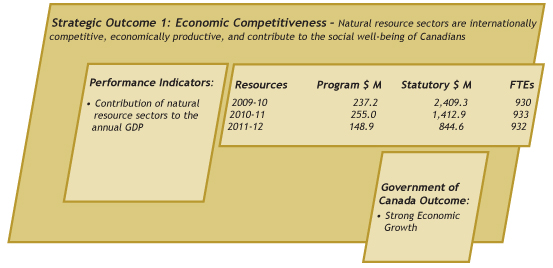
Program Activity 1.1: Economic Opportunities for Natural Resources
Program Activity Summary
This program activity is designed to promote innovation, investment and the enhancement of the competitiveness of Canada's natural resources and related industries through the provision of knowledge and tools, trade promotion and the removal of barriers, at home and abroad. This group of programs delivers policies, regulations and legislative work to manage federal responsibilities associated with Canada's oil, natural gas and electricity sectors, critical energy infrastructure protection, as well as oversight for statutory programs for the Atlantic offshore.
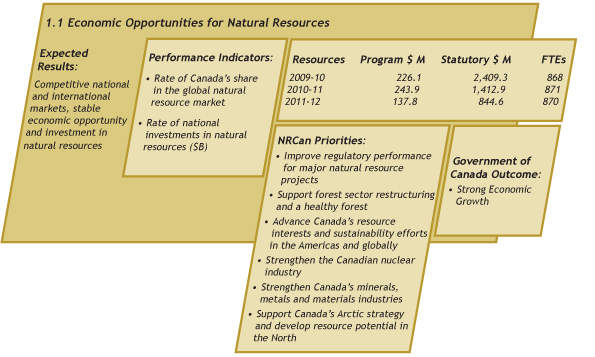
Planning Highlights
To achieve the expected results, NRCan plans to undertake the following key initiatives.
Competitiveness and Innovation: NRCan's objectives are to support enduring, sustainable and transformative change through economic competitiveness, and the preservation and enhancement of market access. This includes support for market diversification and the development of new technologies.
Overall, the department will continue to work with stakeholders on collaborative science and technology and strategic approaches, particularly related to mining and forestry, with a with a view to:
- Increase the number and originality of research ideas as well as the pace of commercialization through the renewal and relocation of the world-class CANMET Materials Technology Laboratory to the McMaster Innovation Park (Hamilton, Ontario);
- Contribute to the implementation of a pan-Canadian mining research and innovation strategy through the Canadian Mining Innovation Council;
- Develop equipment, expertise and scientific knowledge to increase Canadian exports and maintain and strengthen mineral and metal markets, investment, innovation and productivity;
- Develop pre-competitive, non-proprietary forest research to harness emerging and breakthrough technologies, including bioenergy, bioproducts and nanotechnology under the Transformative Technologies Program, delivered in partnership with FPInnovations;
- Create knowledge through collaboration between FPInnovations and NRCan's Canadian Wood Fibre Centre to maximize the forest value chain, from forest resource to market, and to develop new end-uses for wood fibre;
- Expand offshore market opportunities and promoting the environmental credentials of Canada's forest products through programs such as the Canada Wood Export Program and the Leadership for Environmental Advantage in Forestry Initiative; and
- Diversify domestic market opportunities by promoting the use of wood in the North American non-residential sector through the North American Wood First Initiative and improving the competitiveness of the secondary manufacturing wood industry by delivering a national research and technology transfer program under the Value to Wood Program.
New Discoveries of Mineral and Energy Resources: New discoveries in Canada's North will promote economic and social development. The five-year/$100-million Geo-mapping for Energy and Minerals (GEM) Program will lead to the discovery of new northern energy and mineral resources. Moreover, energy and mineral resources are the principal economic drivers in many southern Canadian communities, but known reserves are declining. The Targeted Geoscience Initiative 3 – $5 million per year to 2010 – is working toward finding new base metal deposits around existing sites in Southern Canada.
Nuclear Energy Sector Renewal: Renewing Canada's nuclear energy sector will help to secure a safe, clean, long-term supply of energy. In this regard, NRCan will continue to support the Canadian Nuclear Safety Commission (CNSC) in its efforts to improve the effectiveness and efficiency of nuclear regulatory approval requests; will support Atomic Energy Canada Limited (AECL) in its efforts to renew research and development capacity and infrastructure and to develop the Advanced CANDU Reactor; will review AECL's structure to ensure that it is appropriate in a changing marketplace and positions Canada's nuclear industry to take maximum advantage of domestic and international opportunities; and will work with Health Canada to take steps to ensure that Canadians have a secure supply of medical isotopes.
Participation in High Level Events: In preparation for the Italian (2009) and Canadian G8 Leaders Summits (June 2010) and the World Energy Congress (September 2010), NRCan is working with the Department of Foreign Affairs and International Trade (DFAIT) on potential energy deliverables for Canada. These high-level events provide key opportunities for NRCan to advance Canada's interests in the natural resource sectors.
Benefits to Canadians
Natural resources have contributed to the development of Canada as a modern industrial society generating prosperity (e.g., jobs) and a higher quality of life for generations of Canadians. NRCan programs provide critical support to the forestry sector which is undergoing a significant transformation. They are also providing opportunities for the energy and mineral exploration and development industries (e.g., the Mackenzie Valley gas deposit), smaller exploration companies, service companies and rural and remote Canadian communities.
In 2007, Canada's natural resource sectors contributed 12.6 percent to real gross domestic product (GDP); accounted for over 6 percent of total employment; and were the source for over 43 percent of Canada's merchandise exports (in nominal terms). In terms of investment, Canada's natural resource sector enjoy on average between 20 percent and 25 percent of all capital investment; and accounts for over one-third of Canada's entire stock of foreign direct investment.
Program Activity 1.2: Natural Resource-based Communities
Program Activity Summary
This program activity is targeted on increasing Canada's knowledge of the impacts of the resource sectors' evolution on communities that substantially rely on resource-based industries, and on improving community-based capacity and knowledge for the development and pursuit of opportunities for new and value-added resource-based products and services.
This group of programs is designed to improve the social well-being of Canadians. It is concerned with promoting Aboriginal and non-Aboriginal participation and improving skills, capacity and community stability.
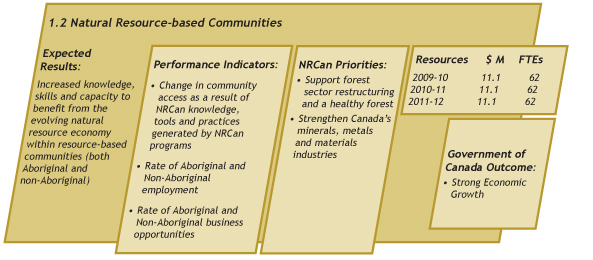
Planning Highlights
To achieve the expected result, NRCan plans to undertake the following key initiatives.
Partnerships and Dialogue: NRCan is working collaboratively with the provinces and territories by creating a task team on the economy to assess the impacts of the economic downturn and the challenges created, and to track government and industry responses. The results of this joint work will be used to develop recommendations to the next federal, provincial and territorial meeting of energy and mines ministers in September 2009.
Collaborative Initiatives: Through its Forest Communities Program, NRCan will develop and share knowledge, tools and best practices, in areas such as innovative forest tenure arrangements, bioenergy and youth engagement in forestry through collaborative working arrangements and initiatives involving eleven community-level organizations, the Canadian Model Forest Network and other partners and stakeholders. NRCan will also work in partnership with Indian and Northern Affairs Canada, other federal departments, industry, Aboriginal organizations and provincial governments to enable Aboriginal communities to participate in, and benefit more fully from major sustainable forest-based economic opportunities across the country.
Benefits to Canadians
Almost 900,000 Canadians are directly employed in the natural resource sectors, making the sector the second-largest employer in Canada, and the largest private sector employer of Aboriginal peoples.
The natural resource sectors support many regions of Canada through the creation of jobs and economic opportunities. Hundreds of communities across Canada are directly dependent on forestry or highly reliant on the mining industry. NRCan is working with these industries to accelerate restructuring, develop new technologies and products, diversify markets and support communities in transition. The department is supporting the federal Regional Development Agencies (RDAs) in the delivery of the Community Adjustment Fund. It will also help monitor and assess the economic and regional impacts of the economic downturn.
Strategic Outcome 2: Environmental Responsibility
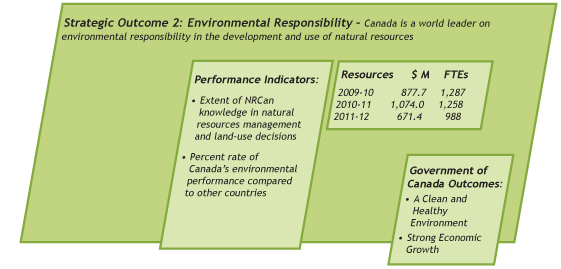
Program Activity 2.1: Clean Energy
Program Activity Summary
Energy production and use are the sources of the majority of air pollution and greenhouse gas emissions in Canada: 85 percent of smog-causing nitrogen oxide emissions; 46 percent of acid rain-causing sulphur dioxide; and 80 percent of greenhouse gases come from the energy sector.
Addressing climate change and air quality through science and technology and adaptation is a priority for the department. This program activity is engaged in the development and delivery of energy science and technology, policies, programs, legislation and regulations to reduce greenhouse gas (GHG) and air pollutant emissions and other environmental impacts associated with energy production and use.
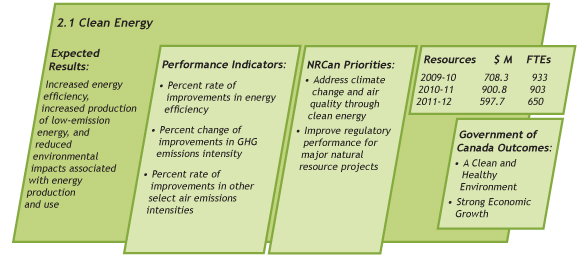
Planning Highlights
To achieve the expected results, NRCan plans to undertake the following key initiatives.
Clean Energy Fund: To further support Canada's leadership in clean energy, the Fund, announced in Budget 2009, will invest in research and the development and demonstration of technologies that have the potential to significantly reduce GHG emissions from the production and use of energy, including through such technologies as large-scale carbon capture and storage.
Canada-U.S. Engagement: Building on the outcome of the successful discussions between Prime Minister Harper and President Obama and the announced Clean Energy Dialogue – via the DFAIT-led whole-of-government engagement strategy with the U.S. – NRCan will focus on collaborative efforts specific to clean energy technology research, development and deployment, particularly of carbon reduction technologies, including next generation coal-fired power such as demonstration projects of carbon capture and storage. Other areas of collaboration include energy efficiency, clean engines and biofuels.
Canada's challenges will be to secure U.S. cooperation on matters of energy security and environmental responsibility. NRCan's approach is to inform, influence and communicate Canada's position on natural resources by highlighting our advantages as a secure place for investment and partnerships. In collaboration with Environment Canada and DFAIT, NRCan has an opportunity to build on the Clean Energy Dialogue and move towards a pragmatic, results-based Clean Energy Partnership with the U.S. with the intention of enhancing North American energy supply and provision of clean energy services by:
- Cleaning our fossil fuels through joint investments in clean energy technology and demonstration;
- Optimizing energy S&T cooperation, research and development;
- Harmonizing of energy efficiency and clean energy performance standards;
- Collaborating on energy infrastructure improvements; and
- Deepening nuclear energy cooperation.
Advanced Materials and Technologies: CANMET Materials and Technology Laboratory will develop advanced materials, technologies and processes to improve energy efficiency and enable clean energy systems through:
- S&T focusing on clean, reliable and efficient power generation;
- S&T supporting Canada's participation in the treaty of the Generation IV International Forum to advance nuclear-based energy systems; and
- developing lightweight structural materials for next-generation vehicles.
ecoACTION Plan: NRCan contributes to the Government's ecoACTION Plan through renewable energy, energy S&T and energy efficiency initiatives and the suite of ecoENERGY programs.
ecoENERGY for Renewable Power Initiative: This initiative will continue to provide incentives to deploy up to 4,000 megawatts of clean electricity from sources such as wind, biomass, small hydro and ocean energy. It will encourage the production of 1.43 terrawatt hours of renewable electricity – enough to power about one million homes – and contribute to the Government's commitment to have 90 percent of Canada's electricity come from non-emitting sources by 2020.
ecoENERGY Technology Initiative: This initiative funds research, development and demonstration activities that support the development of the next generation of energy technologies required to breakthrough to emissions-free energy production and use. It will also generate the new scientific knowledge essential to support Canada's climate change approach, including providing the sound scientific and technical background for establishing meaningful codes and standards. Its work includes:
- Developing knowledge and technologies for the secure supply of affordable and cleaner fossil fuels;
- Promoting clean and efficient energy for the transportation sector;
- Advancing S&T for the efficient and environmentally friendly use of energy in new and existing residential, commercial and institutional buildings;
- Working with industry to develop and improve processes and technologies that improve energy and emissions performance;
- Developing and deploying technologies to create clean, reliable and efficient energy supply technologies, such as carbon capture and storage, which is a technology option — central to the government's climate change approach — that supports the growth of fossil fuel industries while reducing GHG emissions; and
- Striving to harness the availability of bioresources to produce bioenergy, biofuels, bioproducts and industrial bioprocesses.
ecoENERGY Suite of Energy Efficiency Initiatives: To promote programs and regulatory improvements and support continued progress in the energy efficiency of all sectors, and increased production and use of alternative transportation fuels in Canada:
- ecoENERGY for Buildings and Houses, which encourages both the construction and retrofit of more energy-efficient buildings and houses;
- ecoENERGY Retrofit, which offers financial support to retrofit homes (target is middle-income families and seniors), smaller buildings and industrial processes — this includes the $300 million provided in Budget 2009 for the two-year expansion of the program directed at homeowners;
- ecoENERGY for Equipment, which raises energy efficiency standards for a wide range of energy-using products;
- ecoENERGY for Industry, which accelerates energy-saving investments and the exchange of best-practices information within Canada's industrial sector;
- ecoENERGY for Fleets which reduces fuel use and GHG emissions in commercial and institutional fleets;
- ecoENERGY for Personal Vehicles, which provides Canadians with helpful tips and decision-making tools on buying, driving and maintaining their vehicles to reduce fuel consumption and GHG emissions; and
- ecoENERGY for Biofuels, which provides operating incentives to producers of renewable alternatives to gasoline and diesel over the period 2008 to 2017.
Benefits to Canadians
NRCan is helping Canadians improve energy conservation and energy efficiency in every sector of the economy (e.g., homes, commercial buildings, vehicles); accelerate the development and market readiness of technology solutions to reduce environmental impacts associated with the production and use of energy; and increase the production of low-impact renewable energy.
These technologies and programs are not only providing environmental benefits to Canadians but are also encouraging Canada's clean energy industries to access rapidly growing international markets for new technologies, creating new jobs and economic growth while providing new technology choices for energy consumers to save energy and reduce operating costs.
Program Activity 2.2: Ecosystem Risk Management
Program Activity Summary
NRCan is home to a substantial, world-class community of ecosystem and geosystem scientific and technical experts. This program activity provides expertise to ensure that government-wide environmental policies, decision making, regulations and other protection measures pertaining to the natural resource sectors are based on sound scientific information. In addition, this activity reflects our continuing role in the provision of sound scientific advice to regulators to improve the effectiveness and efficiency of regulations such as the Metals Mines Effluent Regulations and other protective measures for projects as required under the Canadian Environmental Assessment Act, the Canadian Environmental Protection Act and other legislation.
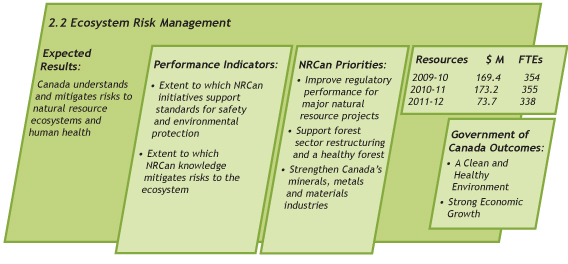
Planning Highlights
To achieve the expected results, NRCan plans to undertake the following key initiatives.
Innovative New Technologies: Through its new Green Mining Initiative, NRCan will continue to conduct research to reduce ecosystem risks from mining and encourage and improve sustainable best practices. With the participation of the mining industry, federal government departments, provincial and territorial governments, regulators, academics and non-governmental organizations, this initiative will focus on four main research themes: footprint reduction; innovation in waste management; ecosystem risk management; and mine closure and rehabilitation. As part of this initiative, NRCan is:
- developing methods to transform mine waste sites into productive land for growing biofuel crops;
- continuing to develop scientifically based technologies and guidelines for the prediction, treatment, prevention and control of acidic drainage;
- conducting research to eliminate contaminated water; and
- developing methods to convert metallurgical slag (waste) into cement for backfill in mining.
Canada's Water Resources Management: Canada is increasingly reliant on groundwater for sustained quality of life. Pressures on water resources are increasing with urbanization, economic expansion and growing energy demands. As these pressures increase with time, governments will face a greater need for scientific advice in order to better manage Canada's groundwater supplies. NRCan's Groundwater Program is focused on producing a national groundwater inventory that will enhance Canada's capacity for informed groundwater decision making. Assessments have been completed for 12 of Canada's 30 key regional aquifers, and mapping will continue to help us to more fully understand this vital resource so that it can be better managed and sustained.
Nuclear Waste Management: The Radioactive Waste Management programs are designed to mitigate risk to the environment and human health. These include the Nuclear Legacy Liabilities Program, a 70-year long-term strategy to deal with legacy decommissioning and radioactive waste liabilities at Atomic Energy of Canada Limited sites, including the implementation of long-term solutions for the associated wastes, as well as ongoing efforts for the clean-up of historic wastes in the Port Hope (Ontario) area and elsewhere in Canada.
Forest Ecosystems Knowledge: Providing a basic understanding of Canada's forest ecosystems at both local and landscape levels ensures that maintaining economic competitiveness does not come at the cost of maintaining environmental integrity. This includes understanding the nature and extent of Canada's forests, their resilience to impacts — natural and human-induced — and forecasting the disturbances and impacts on them, particularly in view of a changing climate. In 2009-10, NRCan will continue to improve forest carbon scientific information and science-based modelling, reporting and policy advice, and will fulfill Canada's forest-related climate change reporting obligations under the United Nations Framework Convention on Climate Change.
Benefits to Canadians
Canadians are concerned about environmental changes, air pollution, water quality and water use issues and the ensuing adverse effects on human health and quality of life. This program activity helps Canadians better understand the risks to ecosystems and the protection of critical resources, such as groundwater.
Strategic Outcome 3: Safety, Security and Stewardship
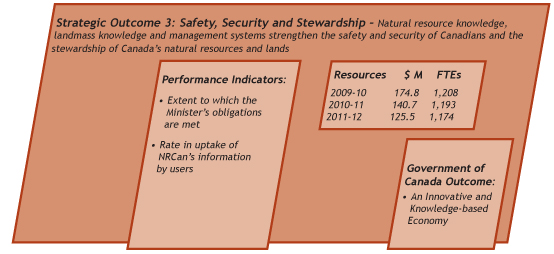
Program Activity 3.1: Adapting to a Changing Climate & Hazard Risk Management
Program Activity Summary
This program activity provides scientific knowledge and expertise on complex climate change adaptation issues that help the government, private sector and communities make policy and development decisions. Science-based information is also made available to reduce risks to Canadians and to support emergency response in the event of natural and human-made occurrences – such as earthquakes, magnetic storms and wildland fire – and to ensure that regulations related to potential hazards arising from human activities, such as explosives and fireworks, are evidence-based and enforced. In addition, the department provides science-based information to help Canadians mitigate and adapt to the potential effects of a changing climate.
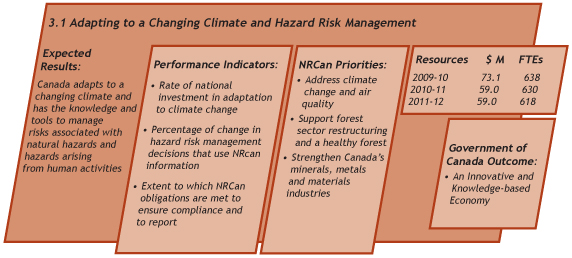
Planning Highlights
To achieve the expected results, NRCan plans to undertake the following key initiatives.
Mining, Infrastructure and Explosives Safety and Security: Continue to optimize the safety and security of workers and the public through the effective regulation of the manufacture, storage, sale and possession of explosives and fireworks through a licensing and inspection program, as per the Explosives Act. Moreover, the department will improve the safety and security of Canadians by conducting research that leads to safer mining, and by improving the integrity of the pipeline infrastructure. The department will fully roll out the implementation of the Restricted Components Regulations by continuing enrolment of vendors of all chemicals restricted under the regulations and undertaking compliance and enforcement activities. NRCan will also move forward with a voluntary initiative with industry partners to strengthen explosives security so that access is limited to legitimate users.
Forest Disturbances: In 2009-10, NRCan will complete the delivery of the Federal Response to the Mountain Pine Beetle (MPB) Initiative in British Columbia with efforts focusing on mitigating the environmental, economic and social impacts. Working in collaboration with the Canadian Council of Forest Ministers, the department will support completion of the first phase of the National Forest Pest Strategy (NFPS), which will provide a risk-based decision-making framework for dealing with native and alien forest pests in Canada. Efforts to combat the MPB will contribute to development of the NFPS and serve as a test case for the pest threat assessment model.
Adapting to a Changing Climate: Adapting effectively to a changing climate requires informed decision making by different levels of government, private sector entities and community organizations on complex adaptation issues that help address regional and sectoral priorities. NRCan's climate change impact and adaptation efforts are helping to ensure that adequate scientific knowledge is in place to move forward on the development and implementation of mechanisms for collaboration between the key players. NRCan is also working with other departments to develop a consistent, coordinated approach to climate change adaptation science and policy work. The department supports regional collaborative groups in their efforts to integrate adaptation considerations into their planning processes ($30 million over 3 years). NRCan is also developing tools to assess climate change impacts that others can use to prepare for a changing climate ($5 million over 3 years). Finally, the department is undertaking basic science in the North and across Canada to better understand the potential impacts of our changing climate.
Natural Hazards: Many parts of Canada are seismically active. The National Seismic Network monitors earthquakes as well as explosions under the Comprehensive Test Ban Treaty. NRCan conducts science related to tsunamis, geomagnetic storms, landslides and volcanic eruptions, knowledge that is essential to the safety of Canadians. The information generated is vital for emergency management, building code development, regulatory standards and monitoring nuclear tests. In the case of earthquakes, floods and other natural disasters, the first step in planning government relief operations is frequently the acquisition of satellite images to assess the damage. NRCan is a key player in the early acquisition of satellite images to respond to natural disasters, both in Canada and abroad through the United Nations.
Benefits to Canadians
The challenge of sustainable resource development and use is the balance of economic growth, social needs and the maintenance of a healthy environment. Through these and other key initiatives, the department is helping Canadians develop the tools and knowledge needed to adapt to climate change. Moreover, NRCan-led science provides a greater understanding of natural hazards, facilitating government response in time of crisis and informing the development of long-term mitigation strategies.
Program Activity 3.2: Natural Resource and Landmass Knowledge and Systems
Program Activity Summary
This program activity carries out the Minister's obligation to provide a property rights infrastructure on all lands for which the department has this responsibility, along with the provision of, and access to, accurate and precise geographic information on the Canadian landmass. This program activity also provides relevant, accurate, timely and accessible knowledge with a view to increasing collaborative efforts with other jurisdictions in key areas – e.g., regulatory efficiency, promotion of innovation – to generate improved approaches to shared issues, and advance the interests of all the natural resource sectors both domestically and at the international level.
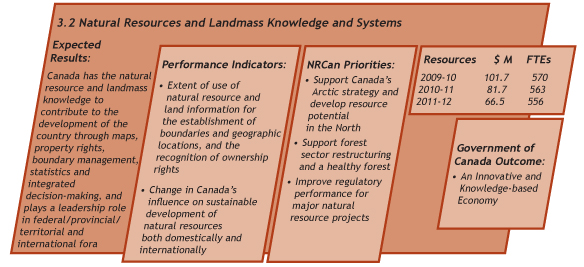
Planning Highlights
To achieve the expected results, NRCan plans to undertake the following key initiatives.
Forest Sector Innovation System: The future competitiveness of the Canadian forest sector is grounded in a redesigned, consolidated and coordinated national forest innovation system. NRCan is actively supporting the consolidation of the national forest research institute FPInnovations, which integrates Forintek, the Forest Engineering Research Institute of Canada, Paprican and the NRCan-created Canadian Wood Fibre Centre. In 2009-10, the department will focus on strengthening partnerships with the university community. The result will be greater focus and coordination among key research organizations on the national research and development priorities that are needed to drive innovation and transformation in the forest sector. The recently announced Forest Sector R&D Initiative, led by the Natural Sciences and Engineering Research Council of Canada in collaboration with NRCan and FPinnovations, is an example of the efforts already being undertaken to bring academic researchers, FPInnovations, industry and government scientists and engineers together in support of forest sector priorities in areas such as energy and chemicals from forest biomass; integrated value maximization; next generation building solutions; next generation pulps and papers; and novel bioproducts from forest biomass.
Maintenance of Canada's Boundaries: To exert sovereignty, a country must properly define and manage its boundaries. The rules of the United Nations Convention on the Law of the Sea present Canada with an opportunity to extend our sovereign rights over the seabed and its resources beyond the 200-mile limit. To take advantage of this opportunity, Canada must map the full extent of its continental shelf. NRCan is working with the Department of Fisheries and Oceans (DFO), the Department of National Defence and international collaborators to collect and interpret the necessary data, and is cooperating closely with DFO and the Department of Foreign Affairs and International Trade in preparation and defence of Canada's claim. The department houses Canada's Surveyor General – who delivers NRCan-legislated responsibilities to manage property surveys including the maintenance of their associated official records on Canada Lands – and jointly manages and maintains, under treaty, the Canada-U.S. boundary in cooperation with the U.S. government. NRCan is also completing the topographic mapping of the North giving Canada complete national coverage, as well as updating the most popular topographic maps in Southern Canada and undertaking efforts to make Canada a major player in the satellite data reception field. In addition, NRCan is working with the Department of Indian and Northern Affairs and other departments on how science and monitoring, logistical support from the Polar Continental Shelf Program and northern satellite ground stations could contribute to the creation of a Canadian Arctic Research Institute.
Regulatory System for Major Natural Resource Projects: The Government has allocated $150 million over five years (starting in 2007) to establish the Major Projects Management Office (MPMO) within NRCan and to increase the scientific and technical capacity of key regulatory departments. The MPMO provides overarching management of the federal regulatory review process for major natural resource projects and operates in close collaboration with other federal regulatory departments and agencies to develop and implement innovative new approaches to continually improve performance. The MPMO provides a single window into the federal regulatory system for all stakeholders and supplies strategic policy advice and support to the Major Projects Deputy Ministers' Committee, which has been established to provide broad oversight and direction for federal regulatory activities pertaining to major resource projects. Through the department's Legislated Environmental and Resource Assessment (LERA) Service, independent authoritative earth science information is provided to support informed decisions for protected areas under federal legislation. LERA also undertakes over 50 project reviews of environmental assessments of development projects each year to ensure that adverse environmental impacts are identified and can be mitigated prior to projects proceeding.
Benefits to Canadians
Fostering innovation, skills, science and technology is of paramount importance in creating a Canadian competitive advantage while protecting the environment. NRCan is supporting increased development in the resource sectors through the creation of a more accountable, predictable and timely regulatory review process. It is also playing a vital role in fulfilling the Government of Canada's Arctic strategy and supporting to economic development in First Nations communities.
Program Activity 3.3: Geomatics Canada Revolving Fund
Program Activity Summary
The Geomatics Canada Revolving Fund (GCRF) was established under Appropriation Act No. 3 in 1993-94. The fund allows Geomatics Canada to shift the costs from taxpayers at large to specific users who benefit directly from the goods and services provided.
This revenue retention mechanism gives Geomatics Canada the ability to recover full costs from Canadian customers and the freedom to charge market prices for international clients. It presents the opportunity to provide an increasing volume of products and services in response to the needs of Canadian clients, as well as supporting the Canadian geomatics industry through the knowledge and expertise necessary to be competitive in the international market.
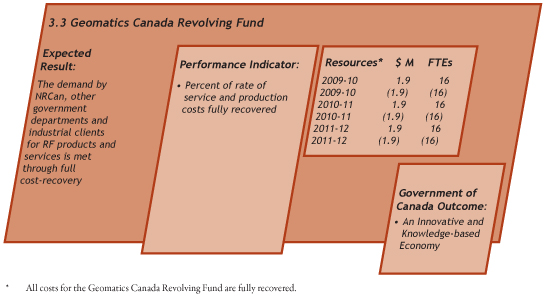
Program Activity 4.1: Internal Services[12]
Program Activity Summary
Internal Services are groups of related activities and resources that are administered to support the needs of programs and other corporate obligations. These groups are: Management and Oversight Services; Communications Services; Legal Services; Human Resources Management Services; Financial Management Services; Information Management Services; Information Technology Services; Real Property Services; Material Management Services; Acquisition Services; and Travel and Other Administrative Services.

Planning Highlights
Renewing NRCan is a department-wide initiative to change the way we work as a department, how we fulfill our mandate, and how we serve the Canadian public. The implementation of NRCan's Strategic Framework is the cornerstone of this major renewal effort. The objective of the Framework is to create an integrated, knowledge-based and results-oriented organization to be achieved through a "one department" approach to planning and reporting, collective leadership, and innovative collaboration and information sharing across the department and with stakeholders in pursuit of common goals.
To support, contribute to, and set the direction of the department's ongoing renewal agenda within the context of the Strategic Framework, three main initiatives have been undertaken: HR Renewal, Knowledge Management and Collaborative Technologies, and the integration of Science and Policy.
HR Renewal: In response to unprecedented human resource and talent management challenges, NRCan has adopted and will deliver on a comprehensive talent management approach, supporting the Clerk's public service renewal action plan. The approach focuses on revitalizing current employees' skills and competencies and recruiting new talent in order to maintain a diverse and talented workforce equipped to deliver results for Canadians now and in the future.
Knowledge Management and Collaborative Technologies: NRCan's mission of becoming a world-class centre of natural resources expertise will continue to be achieved through the implementation of a knowledge gateway. Innovations in collaborative technology such as the NRCan Resource Wiki are already in place to enable NRCan employees to more efficiently preserve, share, integrate and leverage the department's most valuable asset, its knowledge. NRCan will continue to promote and focus on collaborative approaches through the use of technology and information management innovation. Moreover, NRCan will develop approaches to identify, preserve and transfer mission-critical knowledge held by people, notably those about to retire.
Integration of Science and Policy: In pursuit of closer alignment to common objectives and synergy, the department continues efforts to integrate science and policy. NRCan will capitalize on research results and focus on facilitating communication of these results to policy makers who need to understand and integrate this vital information. Moreover, the department is developing a science and technology strategy that aims to create a competitive Canadian advantage in entrepreneurship, knowledge and skilled people.
In addition to the core themes of Renewing NRCan, there are other management practices that will be areas of focus in the planning period.
Financial Management: Within the renewal context, NRCan will also be moving toward the provision of improved financial information, internal controls and systems to inform and strengthen decision making within the department.
Real Property: The NRCan real property portfolio of custodial buildings has an average age of 46 years. NRCan will be focused on addressing significant real property challenges. The department is well positioned to develop solutions through the implementation of an effective real property management framework in support of program and service delivery.
Ministerial Portfolio Coordination: The department recently created the Public Affairs and Portfolio Management Sector to create formal administrative structures tailored to specific portfolio roles, responsibilities and requirements. The implementation of these new structures will serve to complement and build upon the existing responsibilities within the department and portfolio agencies in order to further strengthen the relationships and outcomes.
Benefits to Canadians
These changes are reinforcing NRCan's standing as a world-class centre of knowledge and expertise in a changing world. They are strengthening the department's capacity to provide concise and integrated advice to senior levels of government on the pressing issues of the day. They are enhancing NRCan's ability to provide Canadians with relevant information about the country's vast resource base and landmass.
Section III – Supplementary Information
Links to Additional Information
The following information can be found on the Treasury Board Secretariat's web site at http://www.tbs-sct.gc.ca/rpp/st-ts-eng.asp.
- Details of Transfer Payment Programs Exceeding $5 Million/Year
- 3-year Summary Plan for Transfer Payments[13]
- Up-Front Multi-Year Funding
- Green Procurement
- Sustainable Development Strategy
- Horizontal Initiative – Improving the Performance of the Federal Regulatory System for Major Natural Resource Projects
- Internal Audits
- Evaluations
- Loans, Investments and Advances
- Sources of Respendable and Non-Respendable Revenue
- Summary of Capital Spending by Program Activity
- User Fees
- Geomatics Canada Revolving Fund
[1] The following are the major items contributing to increases in this program activity when compared to fiscal year 2008-09. In 2009-10: $150 million for the ecoENERGY Retrofit for Homes Program (Budget 2009: Canada's Economic Action Plan) and $73 million for ecoENERGY for Biofuels. In 2010-11: $150 million for the ecoENERGY Retrofit for Homes Program (Budget 2009: Canada's Economic Action Plan); $104.6 million for the Clean Energy Agenda; $139.8 million for ecoENERGY for Biofuels and $20.0 million for Sustainable Development Technology Canada. In 2011-12: $144.1 million for the Clean Energy Agenda.
[2] Reduction in this program activity in 2011-12, when compared to fiscal year 2008-09, is attributed to the sunsetting of the Nuclear Legacy Liabilities funding in the amount of $119.7 million.
[3] Major items contributing to the reduction in 2010-11 and 2011-12, when compared to fiscal year 2008-09, are the Implementation of the Adaptation Theme in Support of Canada's Clean Air Agenda ($14.2 million), the Federal Response to the Mountain Pine Beetle Initiative ($9.9 million) and the Forestry Long-Term Competitiveness Strategy ($4.2 million).
[4] Reduction in 2011-12, when compared to fiscal year 2008-09, is mainly due to sunsetting of the Limits of the Continental Shelf initiative ($15.3 million) and Investing in Offshore Development ($5.0 million).
[5] All costs associated with this program activity are fully recovered.
[6] Statutory programs under the Economic Opportunities for Natural Resources program activity – NRCan makes various statutory payments to Nova Scotia and Newfoundland and Labrador through its responsibility for offshore energy resources. The Atlantic Offshore Accords provide that the benefits of revenues from the offshore should flow to provinces as if the resources were on land. These payments include those to the Newfoundland Offshore Petroleum Resource Revenue Fund; the Nova Scotia Offshore Revenue Account; fiscal equalization offset payments to Newfoundland (provide for compensation for part of the reduction in entitlements resulting from offshore revenues); the Canada-Newfoundland Offshore Petroleum Board; and the Canada-Nova Scotia Offshore Petroleum Board (federal and provincial governments each fund half the offshore boards budgets); and the Canada-Nova Scotia Offshore Development Fund (supports projects in Nova Scotia associated with the development of the offshore oil and gas industry, and is authorized to incur expenditures up to $200 million).
[7] Planned spending includes adjustments for Supplementary Estimates Appropriated, Supplementary Estimates Statutory, and new items and announcements identified in Budget 2009: Canada's Economic Action Plan, and other adjustments identified by Treasury Board.
[8] Strategic Outcome #1 Economic Competitiveness; #2 Environmental Responsibility; #3 Safety, Security and Stewardship.
[9] The net change for Vote 1 is a reduction of $62.6 million. This change consistsis of increased funding for Geo-mapping for Energy and Minerals ($21.5 million) and decreased funding for the clean-up of the Port Hope area ($27.6 million), the Forest Industry Long-term Competitiveness Strategy ($8.9 million), the Mountain Pine Beetle Initiative ($8.6 million), CANMET relocation ($7.6 million), Nuclear Legacy Liabilities ($7.4 million) and the Clean Energy Agenda ($7.2 million).
[10] The net change for Vote 5 is an increase of $19.1 million. This reflects increased funding for ecoENERGY for Biofuels ($73.0 million) offset by decreased funding for the Forest Industry Long-term Competitiveness Strategy ($30.6 million) and the Federal Response to the Mountain Pine Beetle Initiative ($21.6 million).
[11] The increase of $20 million reflects funding approved to allow the foundation to make payments to eligible recipients.
[12] The resources for this program activity include $4.5 million per year for the horizontal initiative "Improving the Performance of the Regulatory System for Major Natural Resources Projects". The department is in the process of relocating this initiative under program activity 3.2: Natural Resource and Landmass Knowledge and Systems.
[13] This plan will be available at http://www.nrcan-rncan.gc.ca/com/resoress/pubpub-eng.php after June 30, 2009.